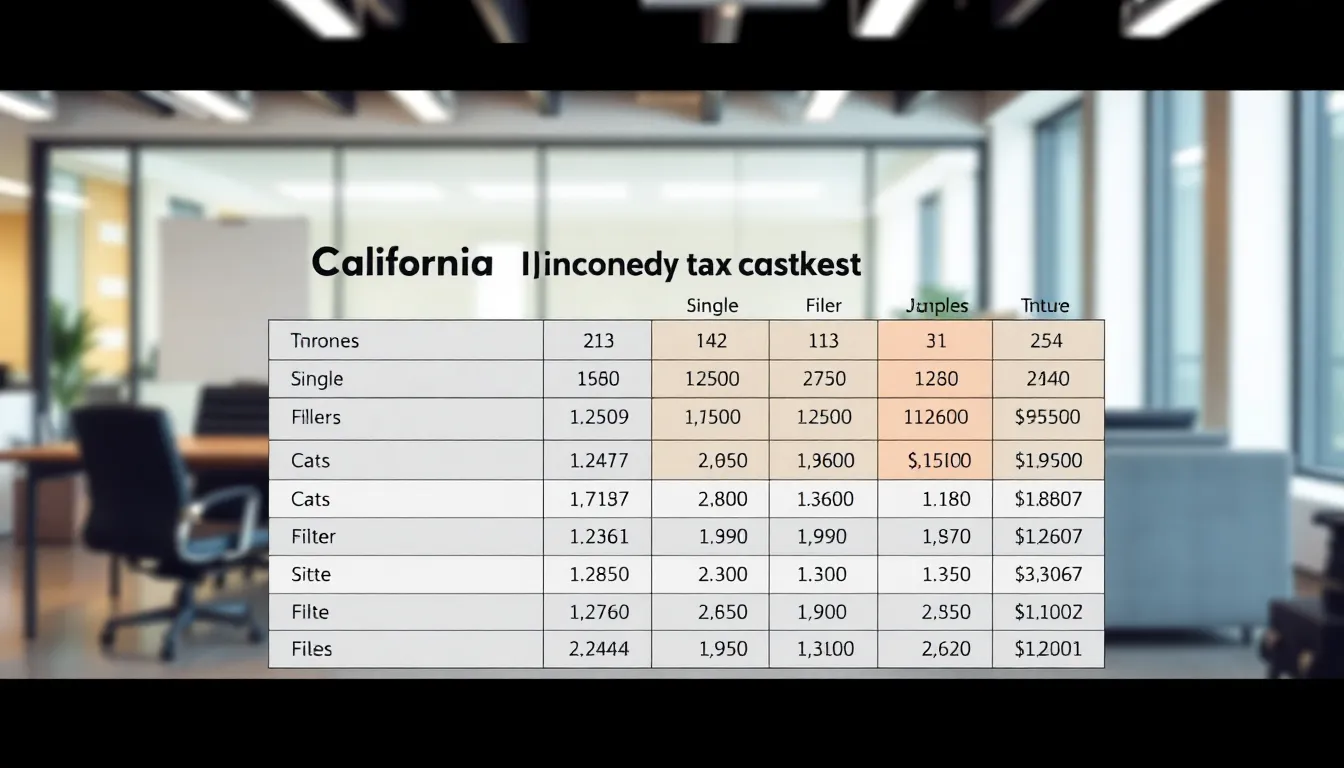As 2024 approaches, Californians are gearing up for potential changes in their income tax obligations. Understanding the state’s income tax brackets is crucial for effective financial planning. With a progressive tax system, California’s rates vary significantly based on income levels, impacting residents in different ways.
Navigating these tax brackets can feel overwhelming, but it’s essential for maximizing deductions and minimizing liabilities. Whether someone is a high earner or just starting their career, knowing where they stand within these brackets can lead to smarter financial decisions. This article will break down the California income tax brackets for 2024, offering clarity on what taxpayers can expect in the coming year.
Table of Contents
ToggleOverview of California Income Tax Brackets 2024
California’s income tax brackets for 2024 reflect a progressive tax system, meaning higher income levels incur higher rates. Understanding these brackets aids in effective financial planning for all taxpayers.
| Tax Rate (%) | Income Range ($) | Filing Status |
|---|---|---|
| 1.0 | 0 – 9,325 | Single |
| 2.0 | 9,326 – 22,600 | Single |
| 4.0 | 22,601 – 40,650 | Single |
| 6.0 | 40,651 – 62,750 | Single |
| 8.0 | 62,751 – 100,000 | Single |
| 9.3 | 100,001 – 1,000,000 | Single |
| 10.3 | 1,000,001 – 2,000,000 | Single |
| 11.3 | Over 2,000,000 | Single |
| Tax Rate (%) | Income Range ($) | Filing Status |
|---|---|---|
| 1.0 | 0 – 18,650 | Married Filing Jointly |
| 2.0 | 18,651 – 45,200 | Married Filing Jointly |
| 4.0 | 45,201 – 81,300 | Married Filing Jointly |
| 6.0 | 81,301 – 125,500 | Married Filing Jointly |
| 8.0 | 125,501 – 200,000 | Married Filing Jointly |
| 9.3 | 200,001 – 2,000,000 | Married Filing Jointly |
| 10.3 | 2,000,001 – 4,000,000 | Married Filing Jointly |
| 11.3 | Over 4,000,000 | Married Filing Jointly |
Each income bracket applies only to income exceeding the lower limit, ensuring a graduated tax system. Taxpayers should remain informed about these rates and consider strategies to optimize their financial situation, particularly regarding deductions and tax credits.
Tax rates and income brackets may change once the state budget is established. Monitoring any updates from the California Franchise Tax Board ensures compliance and awareness of new developments.
Understanding Tax Rates



Tax rates play a crucial role in determining overall tax liability. Understanding the distinction between marginal and effective tax rates enhances financial strategy and planning.
Marginal vs. Effective Tax Rates
Marginal tax rates refer to the tax rate applied to the last dollar of income earned. For instance, if a taxpayer falls into a specific income bracket, only the income above the bracket’s threshold is taxed at the marginal rate. Effective tax rates, on the other hand, represent the average tax rate across all income. Effective rates are calculated by dividing total tax liability by total income. Understanding this distinction aids taxpayers in recognizing how each additional dollar of income impacts their overall tax burden.
Overview of Income Tax Rates for 2024
For 2024, California maintains a progressive tax system with rates ranging from 1% to 13.3%. Here’s a breakdown of the income tax brackets for single filers and married couples filing jointly:
| Filing Status | Income Range | Tax Rate |
|---|---|---|
| Single | $0 – $10,099 | 1% |
| Single | $10,100 – $23,942 | 2% |
| Single | $23,943 – $37,788 | 4% |
| Single | $37,789 – $52,455 | 6% |
| Single | $52,456 – $66,295 | 8% |
| Single | $66,296 – $338,639 | 9.3% |
| Single | $338,640 – $406,364 | 10.3% |
| Single | $406,365 – $677,275 | 11.3% |
| Single | Over $677,275 | 13.3% |
| Married Filing Jointly | $0 – $20,198 | 1% |
| Married Filing Jointly | $20,199 – $47,884 | 2% |
| Married Filing Jointly | $47,885 – $75,576 | 4% |
| Married Filing Jointly | $75,577 – $104,910 | 6% |
| Married Filing Jointly | $104,911 – $132,590 | 8% |
| Married Filing Jointly | $132,591 – $677,278 | 9.3% |
| Married Filing Jointly | $677,279 – $812,728 | 10.3% |
| Married Filing Jointly | $812,729 – $1,354,550 | 11.3% |
| Married Filing Jointly | Over $1,354,550 | 13.3% |
Taxpayers should note that these rates apply only to income within the specified brackets. This structure ensures that higher income earns are taxed at progressively higher rates, reflecting California’s approach to income taxation.
Income Tax Brackets Breakdown
Understanding the income tax brackets is essential for effective financial planning in California. For 2024, California has established specific brackets that vary based on taxpayer status.
Single Filers
For single filers, California’s income tax brackets for 2024 are as follows:
| Tax Rate | Income Range |
|---|---|
| 1% | $0 – $9,325 |
| 2% | $9,326 – $22,600 |
| 4% | $22,601 – $46,350 |
| 6% | $46,351 – $58,635 |
| 8% | $58,636 – $299,508 |
| 9.3% | $299,509 – $359,407 |
| 10.3% | $359,408 – $599,012 |
| 11.3% | $599,013 – $1,000,000 |
| 12.3% | Over $1,000,000 |
| 1% | Mental Health Services Tax on income over $1 million |
Each rate applies only to income exceeding the lower limit of the bracket. Single filers should carefully assess their annual income to determine their obligations accurately.
Married Filing Jointly
For married couples filing jointly, the 2024 tax brackets are:
| Tax Rate | Income Range |
|---|---|
| 1% | $0 – $18,650 |
| 2% | $18,651 – $45,200 |
| 4% | $45,201 – $92,700 |
| 6% | $92,701 – $117,270 |
| 8% | $117,271 – $599,016 |
| 9.3% | $599,017 – $718,814 |
| 10.3% | $718,815 – $1,198,024 |
| 11.3% | $1,198,025 – $2,000,000 |
| 12.3% | Over $2,000,000 |
| 1% | Mental Health Services Tax on income over $1 million |
Each income threshold reflects the unique tax responsibilities for married couples. These brackets encourage accurate reporting of combined incomes.
Head of Household
For taxpayers filing as head of household, the income tax brackets for 2024 are structured as follows:
| Tax Rate | Income Range |
|---|---|
| 1% | $0 – $18,650 |
| 2% | $18,651 – $45,200 |
| 4% | $45,201 – $69,550 |
| 6% | $69,551 – $82,325 |
| 8% | $82,326 – $299,508 |
| 9.3% | $299,509 – $359,407 |
| 10.3% | $359,408 – $599,012 |
| 11.3% | $599,013 – $1,000,000 |
| 12.3% | Over $1,000,000 |
| 1% | Mental Health Services Tax on income over $1 million |
These rates assist heads of households in managing their tax liabilities effectively, reflecting the structure of California’s progressive tax system. Understanding these brackets allows taxpayers to optimize their financial planning strategies.
Additional Considerations
Taxpayers should evaluate various aspects of California’s income tax system to optimize their financial outcomes. Understanding deductions, credits, and how different income levels affect tax liabilities is essential.
Deductions and Credits
Deductions and credits significantly influence taxable income and overall tax liability in California. Common deductions include:
- Standard Deduction: Available to all filers; for single filers in 2024, this amount is set at $5,202, while married couples filing jointly can claim $10,404.
- Mortgage Interest Deduction: Applicable for interest paid on home loans, which can result in substantial tax savings.
- Medical Expenses: Taxpayers may deduct unreimbursed medical costs exceeding 7.5% of their adjusted gross income.
Tax credits, such as the California Earned Income Tax Credit (CalEITC), offer direct reductions in tax liability. For 2024, the CalEITC supports low-income earners, providing credits ranging from $255 to $3,031 based on income levels and family size. Taxpayers should assess eligibility for credits to maximize savings.
Impact on Different Income Levels
Tax liability in California varies significantly across income levels due to the progressive tax structure. Higher earners face increased rates, with taxation starting at 1% and reaching 13.3% for income exceeding $1,000,000 for single filers.
- Low-Income Earners: Those earning below $50,000 typically benefit from lower tax rates and may qualify for the CalEITC.
- Middle-Income Earners: Individuals earning between $50,000 and $250,000 see tax rates ranging from 4% to 9.3%, impacting financial planning strategies.
- High-Income Earners: Taxpayers earning over $250,000 encounter rates up to 13.3%, necessitating careful management of deductions and credits to mitigate tax burdens.
Taxpayers should consider how income fluctuations affect their overall responsibilities. By strategically planning and accounting for potential changes in income levels, individuals can better navigate California’s tax landscape.



